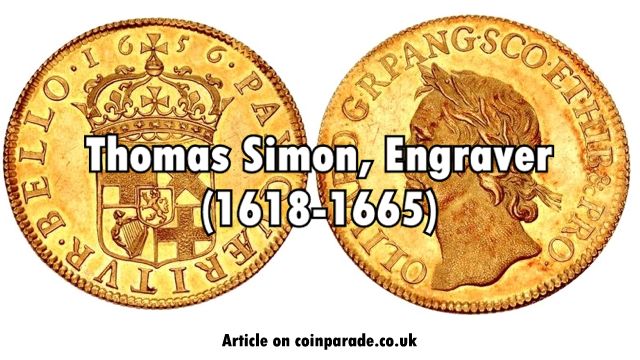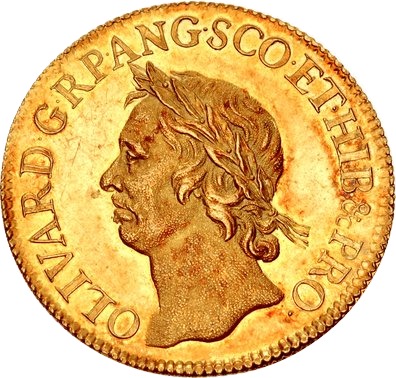
by John Sharples, Curator Emeritus at Museums Victoria
Thomas Simon was the Chief Engraver at the Royal Mint from 1649 to 1660. He was a noted medallist, die and seal engraver and gem engraver. He is perhaps best known for his ‘Petition’ and ‘Reddite’ crowns of 1663 after Charles II had chosen his rivals at the mint, the Roettier brothers, over him.
Simon was born in London in early 1618. In September 1635 he became an apprentice under Edward Green, the chief engraver at the Royal Mint, which was at that time in the Tower of London. During the next seven year working under Green he is believed to have been greatly influenced by Nicholas Briot both in artistic style and in understanding of the new technical developments employing machinery to strike coins and medals. In August 1642, just before he completed his apprenticeship the mint, which was under the control of the King, was taken over by Parliament. Green and Simon were firmly on the side of Parliament and when the Great Seal was taken from London to the King at York it was Simon who made a copy of it for use by the Parliamentarians.
In 1645 Green died and the Parliament appointed Simon and Edward Wade as joint Chief Engravers. Charles I, who was fighting the war from outside London, made his own appointment to this position, Thomas Rawlins. During the remainder of the Civil War the mint continued to produce coins bearing the likeness of the King. Simon was primarily involved with engraving dies for medals but will have taken some part in preparing the coin dies.
Wade died in late 1648 and Simon became the sole Chief Engraver on 21 April 1649 shortly after the execution of Charles I. Parliament moved to have new coins struck for the Commonwealth of England and Simon delegated work on the coinage dies to junior engravers; he was occupied with producing new seals and medals. The Commonwealth coins were produced by the old hammered technique but Parliament was interested in new developments in France. They arranged to bring Peter Blondeau, a French engineer, to London to work with Simon on a proposal to introduce machine struck coins.
Simon engraved the Great Seal of the Commonwealth of England and when Oliver Cromwell became Lord Protector in 1653 it was again Simon to whom the creation of the new Great Seal fell. In 1656 Cromwell ordered patterns made for new gold and silver coins employing Simon as die engraver and Blondeau as engineer. The patterns, though dated 1656, were not actually struck until 1657 and were deemed a great success and a circulation issue was ordered for 1658. Although they were a success they were not struck at the Tower Mint as the moneyers would not accept machine coining. The death of Cromwell in September 1658 saw the Commonwealth revert to the old hammered coinage. Blondeau returned to France but Simon remained at the mint.

In May 1660 Charles II returned from exile in the Netherlands. Simon’s position at the mint was now in trouble. Charles I had appointed Rawlins Chief Engraver and Charles II recognized that appointment. Simon was however retained and appears to have continued to do most of the die engraving.
However in 1660 the King sought dies for a new coinage, wishing to remove all of the coins issued by the Commonwealth from circulation. Simon was given the task but the coins were to be hammer struck so the quality of the die work required was low by his standards and he was reluctant to undertake the work until strongly ordered by the King himself. The coins, when eventually produced, were inferior.
In May 1661 the King issued an order that all coins should be made by machinery. Simon was sent to France to bring back Blondeau. While he was away Charles II, fulfilling a promise made to their father who had helped him when in exile, invited the brothers John and Joseph Roettier to come from the Netherlands to help in the preparation of the new dies. After Simon returned from France friction developed between him and the Roettiers. In February 1662 the King invited Simon and the Roettiers to prepare pattern coins to allow him to choose the engravers for the new milled coinage. The Roettiers submitted a crown but it seems Simon, who had just returned from France did not have enough time to do so. As a result Simon was not chosen to prepare the new coin dies.
However, in early 1663 the King requested some modifications to the Roettiers’ dies and Simon took this as an opportune moment to try to re-engage his claim. He prepared new dies for the obverse and reverse of a crown which incorporated the required modifications, plus two new edge forms. The more famous edge contained a petition to the King in two lines of tiny lettering: THOMAS SIMON MOST HUMBLY PRAYS YOUR MAJESTY TO COMPARE THIS HIS TRYALL PIECE WITH THE DUTCH AND IF MORE TRVLY DRAWN & EMBOSSED MORE GRACE FULLY ORDERED AND MORE ACCURATELY ENGRAVEN TO RELIEVE HIM. The second edge was in Latin: REDDITE QVAE CAESARIS CAESARI (render to Caesar the things that are Caesars). Despite the superiority of Simon’s work his request for advancement fell on deaf ears.
Simon continued to work at the mint as one of the minor chief engravers after 1663 and continued producing dies until his death, possibly from plague, in 1665.
References
- Nathanson, Alan J. Thomas Simon His Life and Work, Seaby Publications, London, 1975.
- Forrer, L, Biographical Dictionary of Medallists – Simon, Thomas, Spink & Son, London, 1912, Vol. V, pp. 519-532.
- Stride, H.G. “Some facts regarding the Petition Crown of Thomas Simon”, Seaby’s Coin and Medal Bulletin, May 1961, 184.
Article Source: Sharples, J. (2010) Thomas Simon, Engraver (1618-1665) in Museums Victoria Collections.
